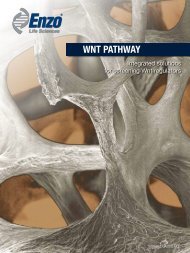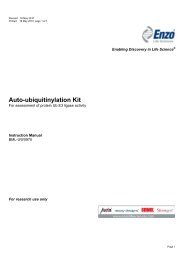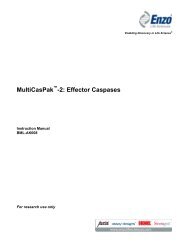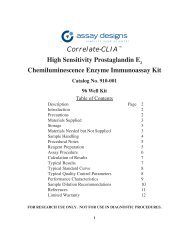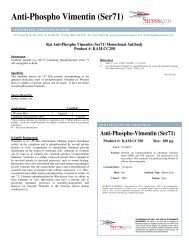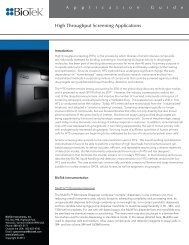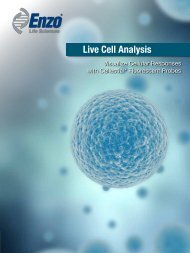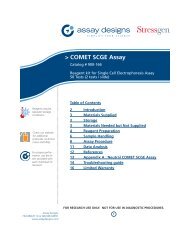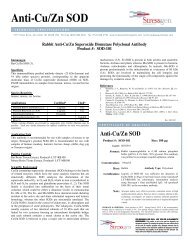User Manual-ENZ-51011 - Rev 2.0 Jan 2010.pub - Enzo Life Sciences
User Manual-ENZ-51011 - Rev 2.0 Jan 2010.pub - Enzo Life Sciences
User Manual-ENZ-51011 - Rev 2.0 Jan 2010.pub - Enzo Life Sciences
- No tags were found...
Create successful ePaper yourself
Turn your PDF publications into a flip-book with our unique Google optimized e-Paper software.
Enabling Discovery in <strong>Life</strong> Science ®Total ROS Detection Kitfor fluorescence microscopy and flow cytometryInstruction <strong>Manual</strong>Cat. No. <strong>ENZ</strong>-<strong>51011</strong>200 fluorescence microscopy assaysor 50 flow cytometry assaysFor research use only.<strong>Rev</strong>. <strong>2.0</strong> <strong>Jan</strong>uary 2010
Notice to PurchaserThe Total ROS Detection Kit is a member of the CELLestial ® product line, reagents andassay kits comprising fluorescent molecular probes that have been extensively benchmarkedfor live cell analysis applications. CELLestial ® reagents and kits are optimal foruse in demanding cell analysis applications involving confocal microscopy, flow cytometry,microplate readers and HCS/HTS, where consistency and reproducibility are required.This product is manufactured and sold by <strong>ENZ</strong>O LIFE SCIENCES, INC. for research useonly by the end-user in the research market and is not intended for diagnostic ortherapeutic use. Purchase does not include any right or license to use, develop orotherwise exploit this product commercially. Any commercial use, development orexploitation of this product or development using this product without the express priorwritten authorization of <strong>ENZ</strong>O LIFE SCIENCES, INC. is strictly prohibited.Limited WarrantyThis product is offered under a limited warranty. The product is guaranteed to meet appropriatespecifications described in the package insert at the time of shipment. <strong>Enzo</strong> <strong>Life</strong><strong>Sciences</strong>’ sole obligation is to replace the product to the extent of the purchase price. Allclaims must be made to <strong>Enzo</strong> <strong>Life</strong> <strong>Sciences</strong>, Inc. within five (5) days of receipt of order.Trademarks and Patents<strong>Enzo</strong> and CELLestial are trademarks of <strong>Enzo</strong> <strong>Life</strong> <strong>Sciences</strong>, Inc. Several of <strong>Enzo</strong>’sproducts and product applications are covered by US and foreign patents and patentspending.
ContentsI. Introduction ............................................................... 1II. Reagents Provided and Storage.............................. 1III. Additional Materials Required ................................. 2IV. Safety Warnings and Precautions ........................... 2V. Methods and Procedures ......................................... 3A. REAGENT PREPARATIONS ..................................................... 3B. CELL PREPARATIONS .............................................................. 4C. FLUORESCENCE/CONFOCAL MICROSCOPY(ADHERENT CELLS) ................................................................. 4D. FLUORESCENCE/CONFOCAL MICROSCOPY(SUSPENSION CELLS) ............................................................. 5E. FLOW CYTOMETRY (ADHERENT CELLS) .............................. 6F. FLOW CYTOMETRY (SUSPENSION CELLS) .......................... 6VI. Appendices ............................................................... 7A. FILTER SET SELECTION .......................................................... 7B. SETTING UP OPTIMAL EXPOSURE TIME FORDETECTION OF THE DYE ........................................................ 7C. ANTICIPATED RESULTS (FLUORESCENCEMICROSCOPY) .......................................................................... 8D. FLOW CYTOMETRY DATA ANLYSIS ANDANTICIPATED RESULTS .......................................................... 8VII. References .............................................................. 10VIII. Troubleshooting Guide ......................................... 10
I. IntroductionFree radicals and other reactive species play influential roles in manyhuman physiological and pathophysiological processes, including cellsignaling, aging, cancer, atherosclerosis, macular degeneration, sepsis,various neurodegenerative diseases (Alzheimer’s and Parkinson’s disease)and diabetes. Once produced within a cell, free radicals can damage awide variety of cellular constituents, including proteins, lipids and DNA.However, at lower concentrations these very same agents may serve assecond messengers in cellular signaling. Information-rich methods arerequired to quantify the relative levels of various reactive species in livingcells and tissues, due to the seminal role they play in physiology andpathophysiology. The Total ROS Detection Kit provides a simple andspecific assay for the real-time measurement of global levels of reactiveoxygen species (ROS), including peroxynitrite, in living cells.This kit is designed to directly monitor real time reactive oxygen and/ornitrogen species (ROS/RNS) production in live cells using fluorescencemicroscopy and/or flow cytometry. The kit includes Oxidative Stress DetectionReagent (Green) as the major component. This non-fluorescent, cellpermeabletotal ROS detection dye reacts directly with a wide range ofreactive species, such as hydrogen peroxide, peroxynitrite and hydroxylradicals, yielding a green fluorescent product indicative of cellular productionof different ROS/RNS types. The kit is not designed to detect superoxideand reactive chlorine or bromine species, as the fluorescent probeincluded is relatively insensitive to these analytes. Upon staining, thefluorescent product generated can be visualized using a wide-field fluorescencemicroscope equipped with standard green (490/525 nm) filter set, orcytometrically using any flow cytometer equipped with a blue (488 nm)laser.II.Reagents Provided and StorageAll reagents are shipped on dry ice. Upon receipt, the kit should be storedat -20°C, or -80°C for long term storage. When stored properly, thesereagents are stable for at least twelve months. Avoid repeated freezingand thawing.Reagents provided in the kit are sufficient for at least 200 microscopyassays or 50 flow cytometry assays using live cells (adherent or insuspension.ReagentOxidative Stress Detection Reagent (Green)ROS Inducer (Pyocyanin)ROS Inhibitor (N-acetyl-L-cysteine)Wash Buffer SaltsQuantity300 nmoles1 µmole2 x 10 mg1 pack1
III. Additional Materials Required CO 2 incubator (37°C) Standard fluorescence microscope or flow cytometer equipped with ablue laser (488 nm) Calibrated, adjustable precision pipetters, preferably with disposableplastic tips 5 mL round bottom polystyrene tubes for holding cells during inductionof ROS/RNS (for suspension cells only) and during staining and assayprocedure Adjustable speed centrifuge with swinging buckets Glass microscope slides Glass cover slips Deionized water Anhydrous DMF (100%)IV. Safety Warnings and Precautions This product is for research use only and is not intended for diagnosticpurposes. Reagents should be treated as possible mutagens and should behandled with care and disposed of properly. Observe good laboratory practices. Gloves, lab coat, and protectiveeyewear should always be worn. Never pipet by mouth. Do not eat,drink or smoke in the laboratory areas. All blood components andbiological materials should be treated as potentially hazardous andhandled as such. They should be disposed of in accordance withestablished safety procedures. To avoid photobleaching, perform all manipulations in low lightenvironments or protected from light by other means.2
V. Methods and ProceduresNOTE: Allow all reagents to warm to room temperature before starting withthe procedures. Upon thawing of solutions, gently hand-mix or vortexthereagents prior to use to ensure a homogenous solution. Briefly centrifugethe vials at the time of first use, as well as for all subsequent uses, to gatherthe contents at the bottom of the tube.A. REAGENT PREPARATIONSReconstitution or dilution of any and all reagents in DMSO should beavoided, as this solvent inhibits hydroxyl radical generation in cells.1. Detection ReagentThe Oxidative Stress Detection Reagent (Green) is suppliedlyophilized and should be reconstituted in 60 L anhydrous DMFto yield a 5 mM stock solution. Upon reconstitution, the stocksolution should be stored at -20°C. Gently mix before use.2. Positive ControlThe ROS Inducer (Pyocyanin) is supplied lyophilized and shouldbe reconstituted in 100 µL anhydrous DMF to yield a 10 mM stocksolution. For use, a final concentration of 200-500 μM is recommended.However, the optimal final concentration is celldependentand should be determined experimentally for each cellline being tested. ROS induction generally occurs within 20-30minutes upon pyocyanin treatment and may decrease ordisappear after that time. Plan accordingly.3. Negative ControlThe ROS Inhibitor (N-acetyl-L-cysteine) should be reconstituted in170 L of deionized water to yield a 0.5 M stock concentration.N-acetyl-cysteine is not readily soluble and may require vortexing.For use, a final concentration of 5 mM is recommended.However, the optimal final concentration is cell-dependent andshould be determined experimentally for each cell line beingtested.Endogenous fluorescence of untreated cells should be determinedin advance or per assay.4. 1X Wash BufferPrepare 1X Wash Buffer by dissolving the contents of the pack in1 liter of deionized water. When not in use, the 1X Wash Buffershould be stored refrigerated. Warm to room temperature before use.3
5. ROS Detection SolutionPrepare the ROS Detection Solution as follows: To every 10 mLof 1X Wash Buffer (see step 4) or culture medium, add 2 µLOxidative Stress Detection Reagent (Green). Gently mix.To prepare smaller volumes of ROS Detection Solution, intermediate1:10dilution of the Oxidative Stress Detection Reagent(Green) in 1X Wash Buffer or culture medium is recommended.B. CELL PREPARATIONSCells should be maintained via standard tissue culture practices.Always make sure that cells are healthy and in the log phase ofgrowth before using them for the experiment.C. FLUORESCENCE/CONFOCAL MICROSCOPY(ADHERENT CELLS)1. The day before the experiment, seed the cells directly onto glassslides or polystyrene tissue culture plates to ensure ~ 50-70%confluency on the day of the experiment.IMPORTANT: Cells should be healthy and not overcrowded sinceresults of the experiments will depend significantly on the cells’condition.2. Load the cells with the ROS Detection Solution (see step A-5,above) using a volume sufficient to cover the cell monolayer andincubate under normal tissue culture conditions for 1 hour.3. Carefully remove the ROS Detection Solution from the glassslides by gently tapping them against layers of paper towel, orfrom tissue culture plates. Optional: Cells may be washed withthe 1X Wash Buffer.4. Treat the cells with an experimental test agent. Separate positivecontrol samples should be treated with the ROS Inducer(Pyocyanin). Negative Control samples should be established bytreatment with the ROS Inhibitor (N-acetyl-L-cysteine).NOTE: Cells should be treated with the ROS Inhibitor 30 minutesprior to induction.All treatments should be performed under normal tissue cultureconditions. It is recommended to perform a pretreatment by addingthe ROS Inhibitor to the aliquots of ROS Detection Solution forthe last 30 minutes of the reagent loading. Treatment with anexperimental test agent or ROS inducer included with the kitshould be performed in the cell culture media without dye.5. Carefully wash cells twice with 1X Wash Buffer in a volumesufficient to cover the cell monolayer.4
6. Immediately overlay the cells with a cover slip and observe themunder a fluorescence/confocal microscope using standard excitation/emissionfilter sets. Oxidative stress detection requires a filterset compatible with Fluorescein (Ex/Em: 490/525nm). Make sureprepared samples are protected from drying. Dried out cells maypresent different fluorescence patterns.D. FLUORESCENCE/CONFOCAL MICROSCOPY(SUSPENSION CELLS)1. Cells should be cultured to a density not to exceed 1 x 10 6 cells/mL. Make sure that cells are in the log phase of growth beforestarting an experiment.IMPORTANT: Cells should be healthy and not overcrowded sinceresults of the experiments will depend significantly on the cells’ overallcondition. A sufficient volume of cells should be centrifuged at 400 x gfor 5 minutes, yielding a working cell count of 1 x 10 5 cells/sample.2. Resuspend the cell pellet in 200 L of ROS Detection Solution(see step A-5, page 4) and incubate under normal tissue cultureconditions for 1 hour with periodic shaking.3. Centrifuge the cells at 400 x g for 5 minutes to remove the ROSDetection Solution. Optional: Resuspend the cells in 5 mL1X Wash Buffer, centrifuge them at 400 x g for 5 minutes andremove the supernatant.4. Treat the cells with an experimental test agent. Separate positivecontrol samples should be treated with the ROS Inducer(Pyocyanin). Negative Control samples should be established bytreatment with the ROS Inhibitor (N-acetyl-L-cysteine).NOTE: Cells should be treated with the ROS Inhibitor 30 minutesprior to induction.All treatments should be performed under normal tissue cultureconditions. It is recommended to perform a pretreatment byadding the ROS Inhibitor to the aliquots of ROS Detection Solutionfor the last 30 minutes of the reagent loading. Treatment withan experimental test agent or ROS inducer included with the kitshould be performed in the cell culture media without dye.5. Centrifuge the cells at 400 x g for 5 minutes.6. Resuspend the cells in 5 mL of 1X Wash Buffer, centrifuge themat 400 x g for 5 minutes and remove the supernatant.7. Resuspend the cells in 100 L of 1X Wash Buffer and apply a20 L aliquot of the cell suspension, sufficient for 2 x 10 4 cells,onto a microscope slide. Immediately overlay the cells with acover slip and analyze via fluorescence microscopy. Oxidative5
stress detection requires a filter set compatible with Fluorescein(Ex/Em: 490/525nm). Make sure that prepared samples areprotected from drying. Dried out cells may present different fluorescencepatterns.E. FLOW CYTOMETRY (ADHERENT CELLS)1. The day before the experiment, seed the cells on appropriate tissueculture plates to ensure ~ 50-70% confluency on the day ofthe experiment.IMPORTANT: Cells should be healthy and not overcrowded sinceresults of the experiments will depend significantly on the cells’condition.2. Induce the cells with an experimental test agent. Separate positivecontrol sample should be treated with the ROS Inducer(Pyocyanin). Negative Control samples should be established bytreatment with the ROS Inhibitor (N-acetyl-L-cysteine)NOTE: Cells should be pre-treated with the ROS Inhibitor at least30 minutes prior to induction.All treatments should be performed under normal tissue cultureconditions.3. Remove the media with the inducers/inhibitors from the cells byaspiration. Carefully wash cells twice with 1X Wash Buffer in avolume sufficient to cover the cell monolayer, aspirate the supernatant.4. Detach cells from the tissue culture plates using any appropriatemethod, collect cells in 5 mL round-bottom polystyrene tubes andwash them with 1X Wash Buffer. Centrifuge the cell suspensionfor 5 min. at 400 x g at room temperature. Discard the supernatant.5. Resuspend the cell pellet in 500 mL of ROS Detection Solution(see step A-5, page 4). Stain cells for 30 min. at 37°C in the dark.No washing is required prior to the analysis of the samples by flowcytometry.F. FLOW CYTOMETRY (SUSPENSION CELLS)1. Cells should be cultured to a density not to exceed 1 x 10 6 cells/mL. Make sure that cells are in the log phase of growth beforestarting an experiment.IMPORTANT: Cells should be healthy and not overcrowded sinceresults of the experiments will depend significantly on the cells’ overallcondition. A sufficient volume of cells should be centrifuged at400 x g for 5 minutes, yielding a working cell count of 1-5 x 10 5 cells/sample.6
2. Induce the cells with an experimental test agent. A separatepositive control sample should be treated with the ROS Inducer(Pyocyanin). A negative control sample should be established bytreatment with the ROS Inhibitor (N-acetyl-L-cysteine).NOTE: Cells should be pre-treated with the ROS Inhibitor 30 minutesprior to induction.All treatments should be performed under normal tissue cultureconditions.3. Centrifuge the cells at 400 x g for 5 minutes. Discard supernatatant.4. Resuspend the cells in 5 mL of 1X Wash Buffer, centrifuge themat 400 x g for 5 minutes and remove the supernatant.5. Resuspend the cells in 500 μL of the ROS Detection Solution(see step A-5, page 4) and incubate 30 min at 37°C in the dark.No washing is required prior to the flow cytometry analysis.VI. AppendicesA. FILTER SET SELECTIONFor fluorescence microscopy, careful consideration must be paid tothe selection of filters. Dichroic filters should be selected in which the“cut-off” frequency is optimally mid-way between the two emissionbands that are desired (one reflected, the other transmitted).However, it is important to realize that dichroic filters have a somewhatlimited reflectance range, i.e., a 600 nm short-pass dichroic filtermay actually reflect light
Avoid saturation of the signal (very bright spots on the image). Ifsaturation of the signal occurs, decrease the exposure time. It isrecommended to acquire 5-6 single color images for each sample.C. ANTICIPATED RESULTS (FLUORESCENCEMICROSCOPY)1. It is critical that positive (pyocyanin-induced) and control(untreated) samples be included in every experiment for every celltype. Negative (ROS Inhibitor-pretreated) sample is optional butvery helpful. In preliminary experiments, it is important to establishappropriate doses of inducers and inhibitors for each cell typeused.2. Increased levels of oxidative stress give a uniform green cytoplasmicstaining in the presence of the Oxidative Stress DetectionReagent (Green).3. ROS positive control samples, induced with ROS Inducer(Pyocyanin), exhibit a bright green fluorescence in the cytoplasm.4. Cells pretreated with the ROS Inhibitor (N-acetyl-L-cysteine)should not demonstrate any green or orange fluorescence uponinduction.5. Untreated samples should present only low autofluorescent backgroundsignal in any channel.D. FLOW CYTOMETRY DATA ANALYSIS AND ANTICIPATEDRESULTS1. It is critical that positive (pyocyanin-induced) and control(untreated) samples be included in every experiment for every celltype. Negative (ROS Inhibitor-pretreated) sample is optional butvery helpful. In preliminary experiments, it is important to establishappropriate doses of inducers and inhibitors for each cell typeused.2. Cell debris should be gated out using FSC versus SSC dot plot.3. Generate a log FL1 (X-axis) versus a log FL2 or SSC (Y-axis) dotplot and add quadrants to it. Adjust quadrants so the majority ofcontrol cells (80-90%) will fall into lower left quadrant. Keep thesame quadrant gate throughout the assay. Alternatively, log FL1histogram can be used, where the mean fluorescence of the peakfor the untreated cells should fall within the first decade of a logFL1 scale.NOTE: Remember that different cell types demonstrate differentredox profiles therefore the number of the cells in the lower leftquadrant may vary significantly between the cell lines.8
4. Cells with increased levels of oxidative stress demonstrate brightgreen fluorescence in the presence of the Oxidative Stress DetectionReagent and will be detected using FL1 channel. Such cellswill appear in the two right quadrants of a log FL1 (X-axis) versusFSC or SSC dot plot. If log FL1 histogram is used, the peak generatedby the ROS positive cells will have increased FL1 fluorescencecompared to a control cells’ fluorescence.5. ROS positive control samples, induced with ROS Inducer(Pyocyanin), exhibit bright green fluorescence and appear to bepositive in FL1 channel.6. Cells pretreated with the ROS Inhibitor (N-acetyl-L-cysteine)should not demonstrate significant green fluorescence uponinduction.7. Control (untreated) samples should present only low autofluorescentbackground signal in any channel thus falling into the firstdecade on a log FL2 scale.Results of the experiments can be presented as percentage of thecells with increased ROS production or as increase in the mean fluorescenceof the induced samples versus control.ABFigure 1. Jurkat cells were induced with 100 μM pyocyanin (general ROS inducer, panel A),or 1 μM of t-butyl-hydroperoxide (peroxide inducer, panel B), stained with Total ROS DetectionReagent and analyzed using flow cytometry. Untreated cells were used as a control. Celldebris were ungated. The numbers in the inserts reflect the mean green fluorescence of thecontrol and treated cells.9
VII. References1. Tarpey, M. and Fridovich, I. Circ Res. 89 (2001), 224-236.2. Batandier ,C., et al. J Cell Mol Med. 6 (2002), 175-187.3. Gomes, A., et al. J Biochem Biophys Meth. 65 (2005), 45-80.4. Wardman, P. Free Rad Biol Med. 43 (2007), 995-1022.VIII. Troubleshooting GuideProblem Potential Cause SuggestionDead or stressed(overcrowded) cellsBand pass filters are toonarrow or not optimal forfluorescent probes(fluorescence microscopy)Prepare fresh cell culture for theexperiments. Make sure that thecells are in the log growth phase.Multiple band pass filters sets provideless light than single bandpass ones. Check Methods andProcedures section of this manualand Appendix A for recommendations.Insufficient fluorescent dyeconcentrationFollow the procedures provided inthis manual.Low or no fluorescentsignal in positivecontrolInsufficient inducer concentrationSpecies of interest mayreact with each other, thusattenuating the expectedsignal.Determine an appropriate concentrationof inducer for the cell line(s)used in the study.Check signaling pathways and allthe components present in thecellular environment.Inappropriate time point ofthe detectionMake sure that time of detection isoptimized and the samples areprepared immediately.Green signal may quench ifconcentration of product becomestoo high (due to long exposure tothe inducer). Otherwise, oxidizedproduct may eventually leak out ofthe cells when left for a prolongedperiod.10
Problem Potential Cause SuggestionStressed (overcrowded)cellsPrepare new cell culture for theexperiment. Make sure that thecells are in the log growth phase.High fluorescentbackgroundBand pass filters are toonarrow or not optimal forfluorescent probes.Wash step is necessary.Inappropriate time point fordetectionUse correct filter for each fluorophore.Check Methods and Proceduressection of this manualand Appendix A for the recommendations.Follow the procedures provided inthis manual, making optional washsteps mandatory.Make sure that time of detection isoptimized and the samples areprepared immediately.Inappropriate cell conditionsMake sure that you have viablecells at the beginning of theexperiment, and that the inducertreatment does not kill the cellsduring the time frame of theexperiment .Inappropriate inhibitorconcentration (too low or toohigh)Very low doses of inhibitor maynot affect ROS production byinducer. Alternatively, very highdoses of the inhibitors may causeoxidative stress itself and generatefluorescent signal. Optimizethe concentration of the inhibitorand pretreatment time for eachparticular cell line.No decrease in thefluorescent signalafter using a specificinhibitorInappropriate time point fordetectionWhen cells are kept too long withthe inhibitors or at very high inducerconcentrations, after a certaintime, the inhibitor becomesinsufficient. Make sure that timeof detection is optimized.Inappropriate filter set on themicroscopeUse correct filter for excitation andemission. Check Methods andProcedures section of this manualand Appendix A for the recommendations.11
www.enzolifesciences.comEnabling Discovery in <strong>Life</strong> Science ®



